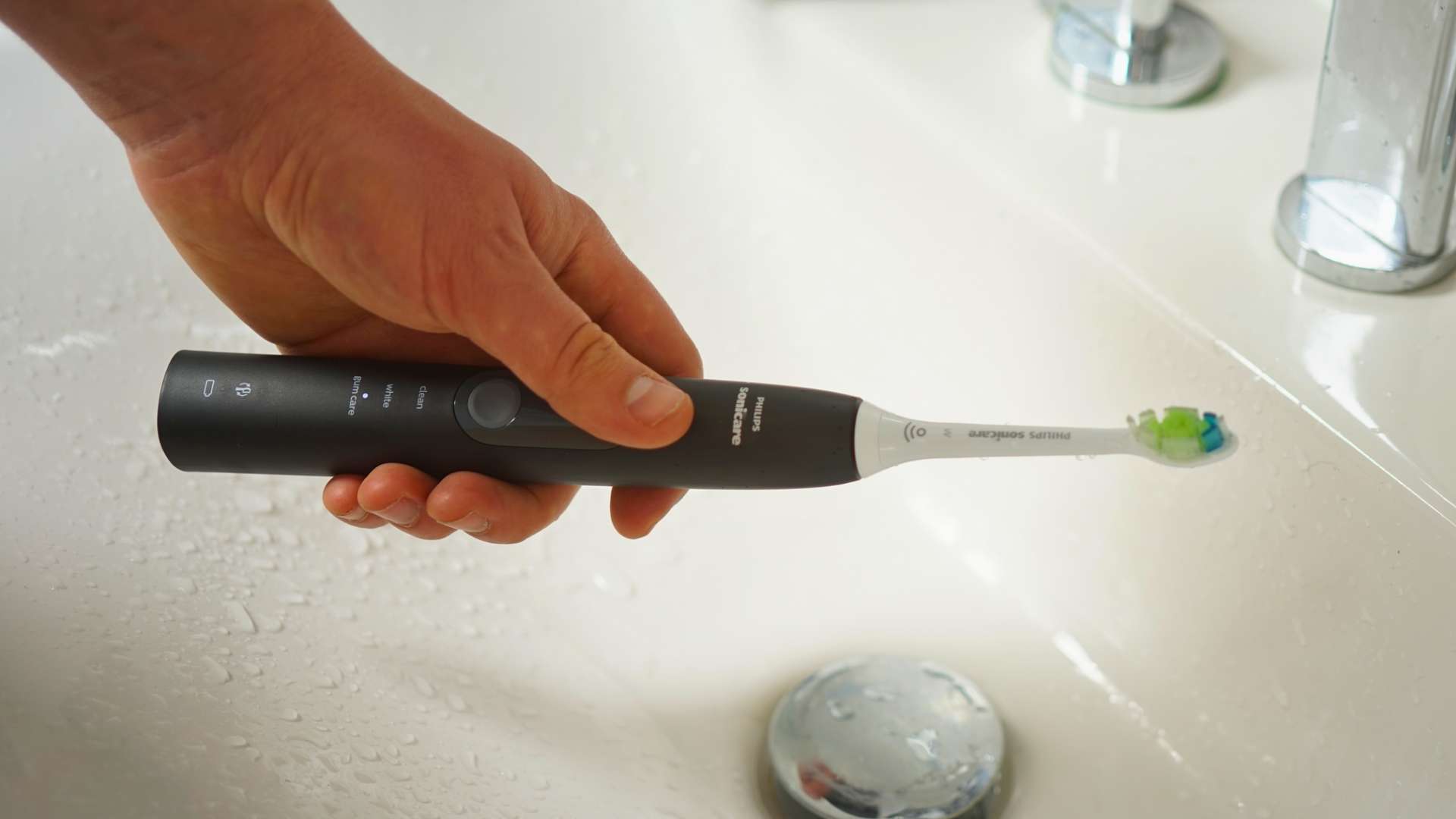
A good mid range brush that will serve you well
If you want the ‘best value’ electric toothbrush going without lots of extra features this is not the one for you.
But, if you want something a little more capable, with a few more nice to haves then the 5100 is worth serious consideration.

Pros |
Cons |
|---|---|

Reminds you when to replace your brush head |
Extra modes as not essential |

Travel case included |
|

Long battery life |
Consider these other brushes
There are countless alternative toothbrushes that you could consider and truth be told most electric toothbrushes available today, will do a great job of cleaning the teeth, when used correctly.
We are constantly reviewing products and when appropriate revising our list of best electric brushes. It is the Oral-B Smart 1500 that is our top recommendation due to the value for money and all round performance it offers.
For those who like the sonic cleaning action and Philips brands, the 4100 Series is going to work out more cost effective than the 5100 in most instances. You will forgo a travel case and the extra cleaning modes, but the cost saving is likely worth it. It cleans the teeth just as well.

Design, usability, clean & general use
The 5100 might be a new brush that brings features in at a price point not previously achieved, but nothing offered is completely new here.
This might sound like a negative, but it is actually a good thing.
It means that all of the elements that make up the 5100 are tried and tested and I like tried and tested because the result is the fantastic ProtectiveClean 5100.
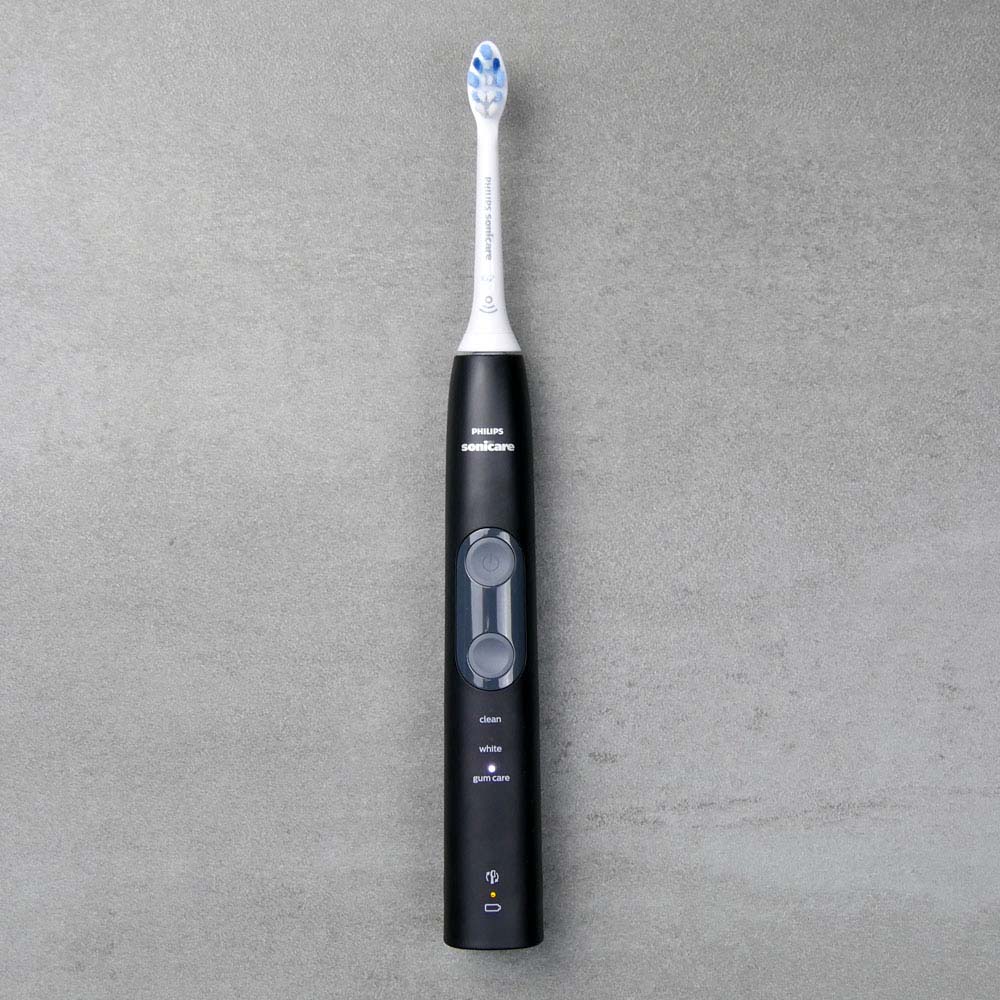
It most certainly looks and feels the part and perhaps better quality than you might have expected for the price.
For those that have not used a Sonicare toothbrush before, may not understand me when I say it has a very ‘Sonicare’ feel to it.
There is just something about a Sonicare product. I am not sure if is the materials, the look and feel or more likely a combination of all of these that give a sense of satisfaction and reassurance.
I mentioned it in my review of the ProtectiveClean 4100, but I feel it is worth mentioning in this review too; Sonicare does a pretty decent job on their packaging.
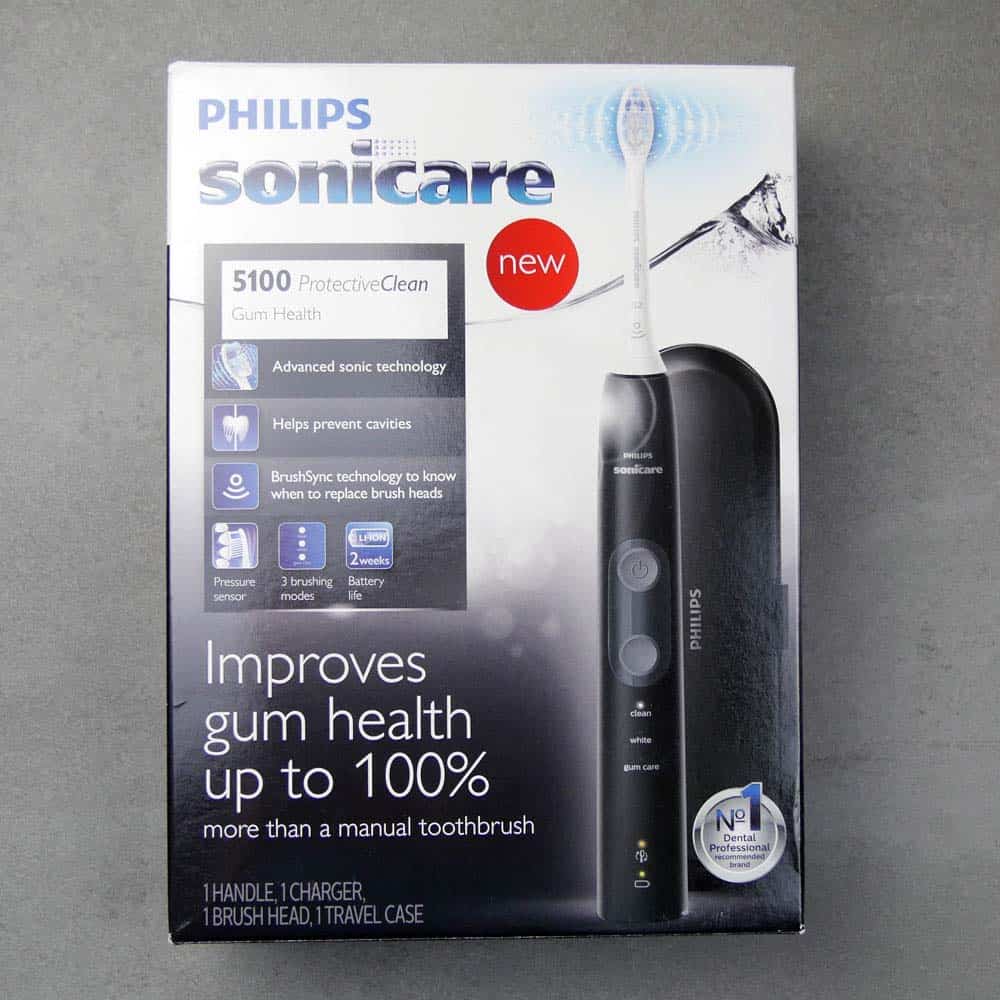
Let’s be honest an electric toothbrush is not the best for the environment, so it's great to see that cardboard box and inner tray are recyclable, unlike the polystyrene packaging that comes with Oral-B products.
I am not sure the little plastic bags the brush handle and charger come in are really necessary, but I guess Sonicare have their reasons.
Out of the box and in the hand, the ProtectiveClean 5100 feels great. Solid and well balanced.
At the time of review, it comes in 2 different color options, the black gray as shown in the hands-on images as well as a white and mint color combination.
A nice touch, not often seen is that the charging stand and travel case provided color matched. This is where a little extra finesse and quality shows and often why Sonicare charge a premium.
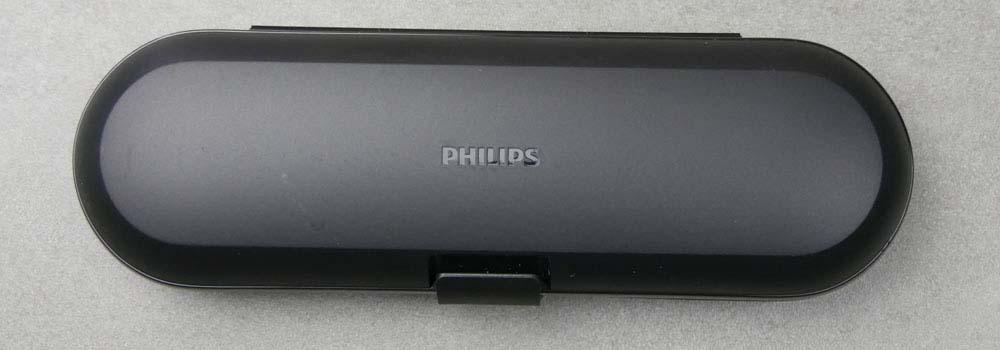
Interestingly, the brush head is white in color.
Ok, black and White are a classic color combination, but would a black brush head not have finished the stealthy look off a bit better?
2 primary parts make up the electric toothbrush, they are the brush handle and the detachable and interchangeable brush head.
Let’s take a look at the brush handle design in detail followed by the brush head and some of the features the pair offer.
So, like most other electric toothbrushes, the 5100 is rounded in its shape and feel in the hand.
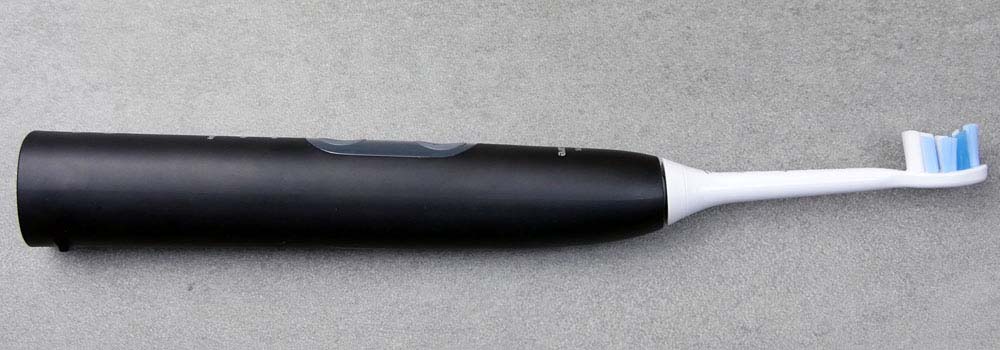
It is has a slightly chunky feel to it but can be gripped nicely in the hand.
I am testing the black gray color option here which has a more matt look and feel.
Even the white unit has a more matt color finish than the gloss finish that is quite common with such products.
The finish on the plastic is such that it actually feels quite grippy, despite not having additional rubber grips and contours to the handle like some others do.
I think for some people, older children and maybe the elderly, a few rubber grips might have helped just give that extra feeling of security and grip in hand, but the ProtectiveClean does not feel all that slippy in hand.
On the front of the handle, at the top, is the Philips Sonicare logo.
Placed somewhere between a third of the way and half way down the brush handle are 2 buttons.
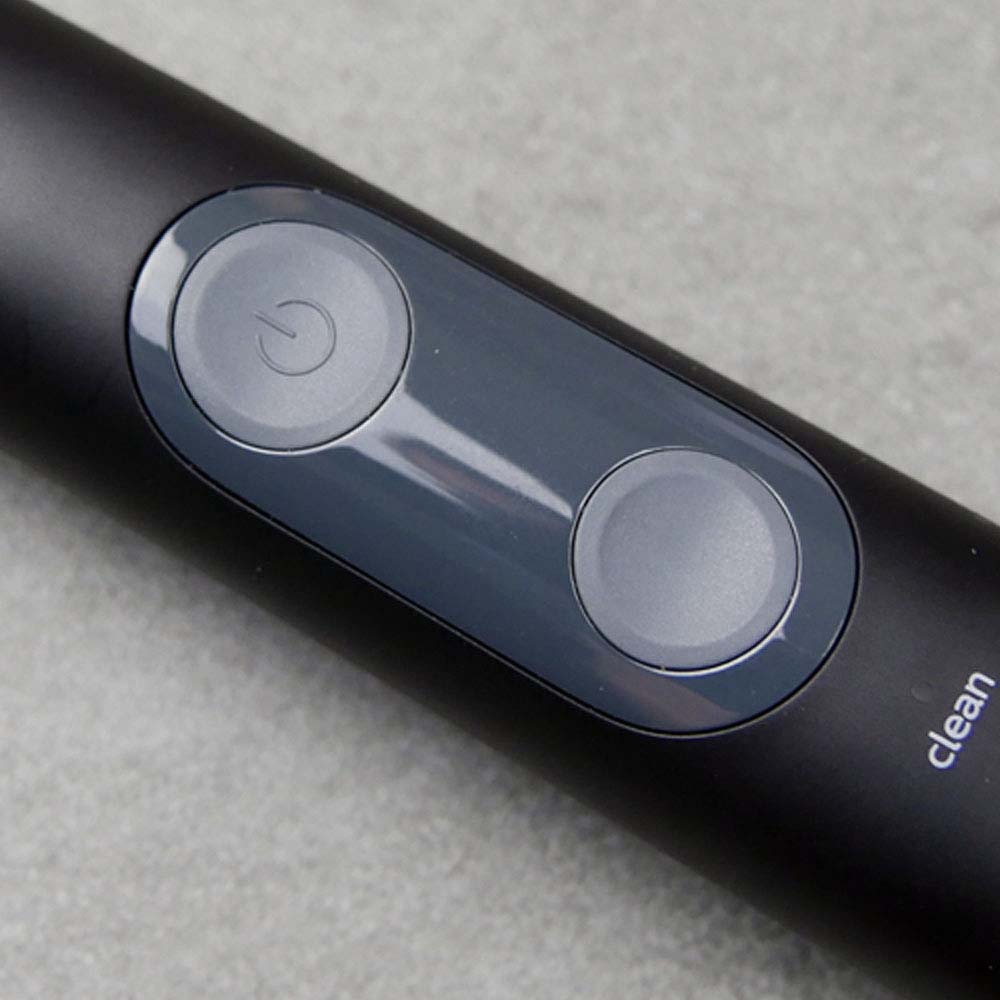
The upper button is the power button, this turns the brush on and off.
The lower button is the cleaning mode/function button that switches between the 3 cleaning modes available on this brush handle.
A power symbol is embossed onto the concave rubber button and makes for a natural place to rest the thumb.
The cleaning mode/function button has no icon on it and is smooth to the touch.
The buttons are relatively easy to press with a bit of feedback.
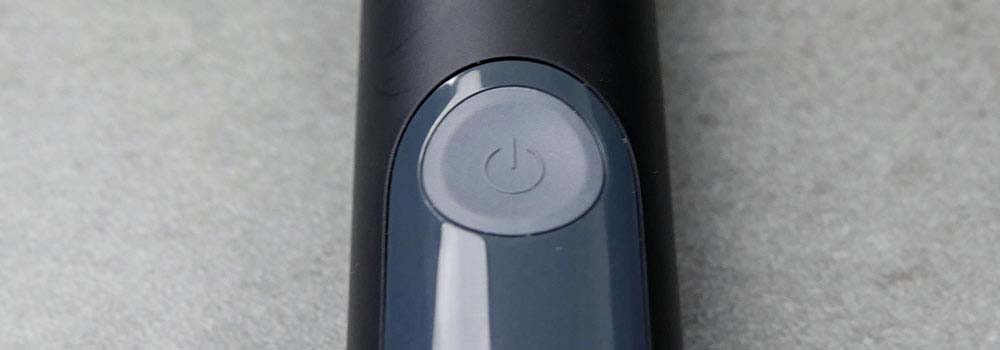
Surrounding these buttons is a plastic panel that gives a color accent to the brush handle.
This is a glossy black color on the black gray model shown in the hands-on photos.
On the white and mint color option, both the buttons and the panel have a mint color finish. The color is duller on the buttons than the plastic panel.
On either color handle, it is a nice accent to give a touch of style.
Sitting below these buttons are the LEDs and names of the cleaning modes.
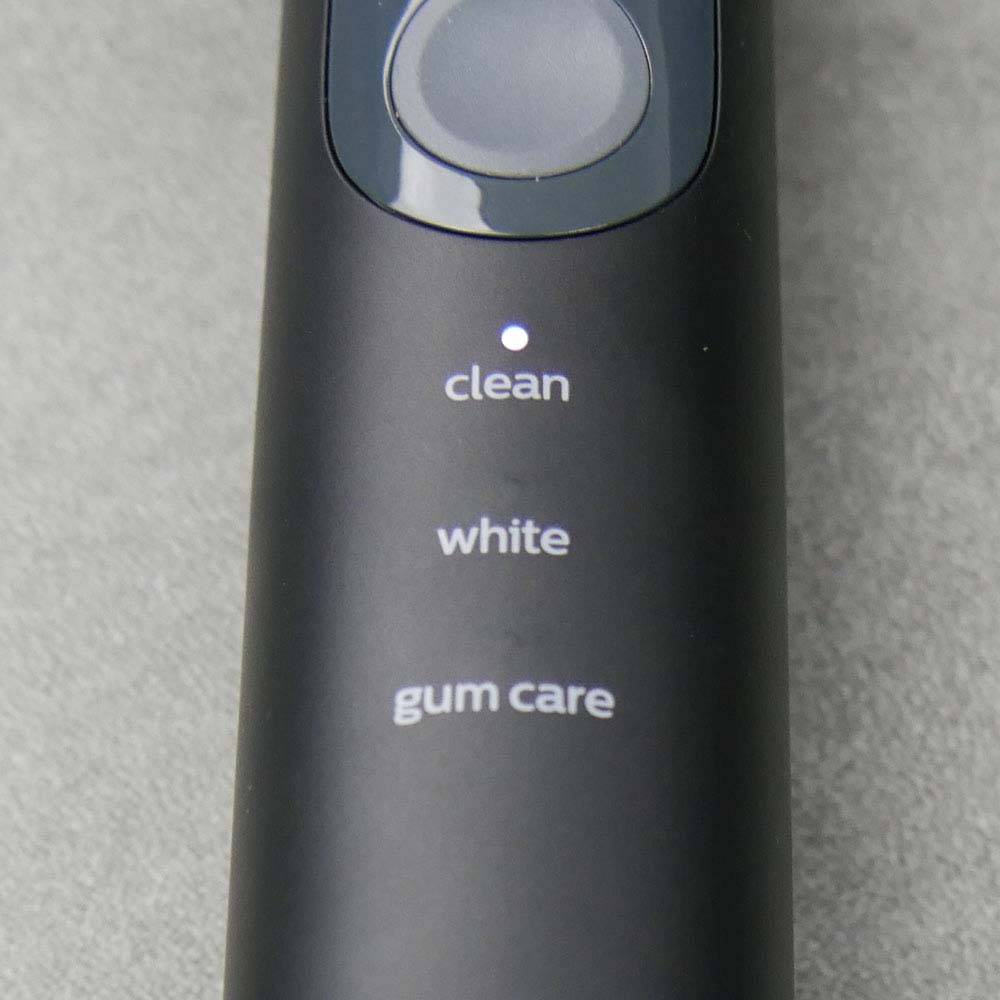
Running top to bottom you have 'Clean', 'White' and 'Gum Care', with the LED sat above the cleaning mode name.
The LED for the cleaning mode lights up as it is selected. Press the cleaning mode button to cycle through the modes, until you get to the mode you want.
The mode can be changed before the brush is switched on.
The brush will remember the last cleaning mode used and begin in that mode the next time the brush is powered on.
The LEDs should not be underestimated in their importance. Oral-B models like the 1500 and 3000 offer multiple cleaning modes, but no easy way to actually know what mode you have selected. The LEDs do this job nicely.
Right towards the bottom of the brush handle are a further 2 LEDs and icons.
First sits the BrushSync LED and symbol, below that battery LED and symbol
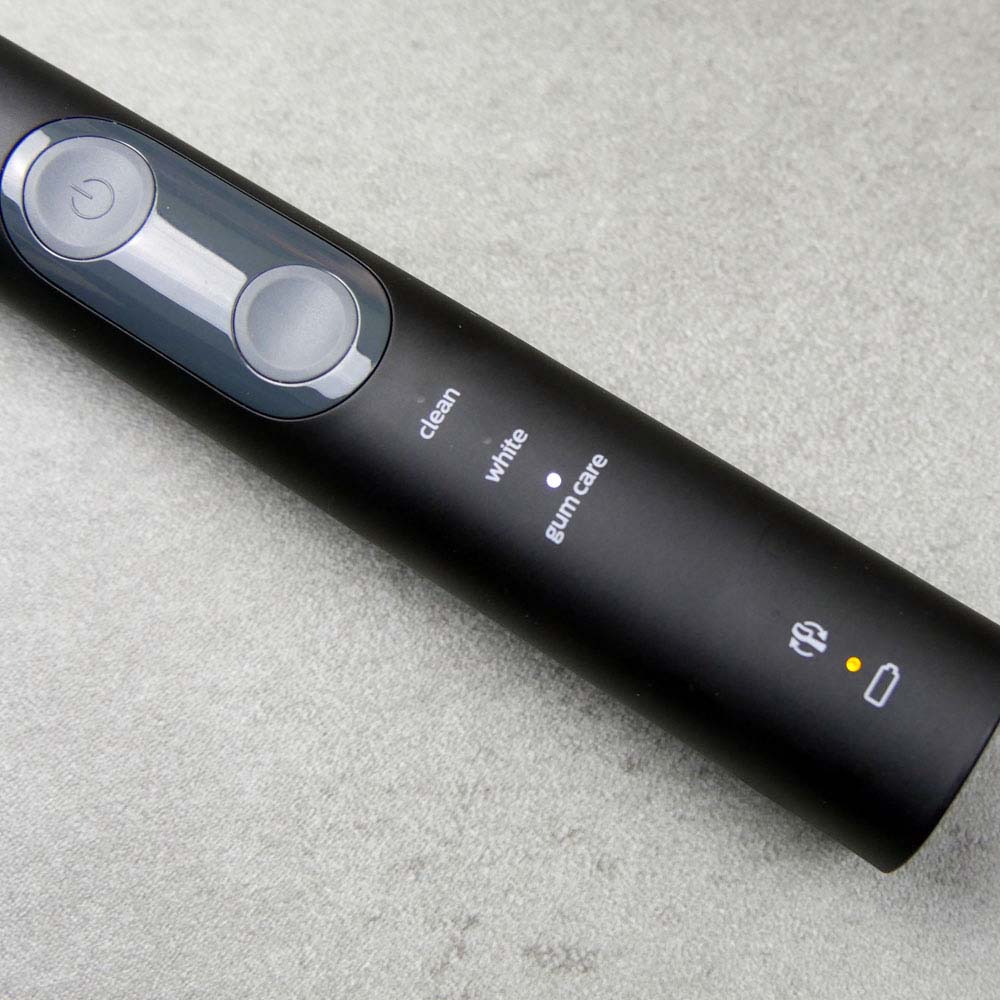
The LED for the battery lights up and flashes in a few different ways. Check out the ‘Battery Life’ section of this review for more information on that.
The back of the handle is smooth to the touch. No ridges or extra grips, with the exception of a little protrusion at the bottom of the handle.

It seems a bit out of place and not immediately obvious what it is for. But, lay the brush on a flat surface, and this raised molding stops the brush rolling about. Genius!
On the base of the brush handle is a recess into which the prong on the charging stand fits.
The brush will sit upright on a flat surface and does too sit upright on the charging stand.
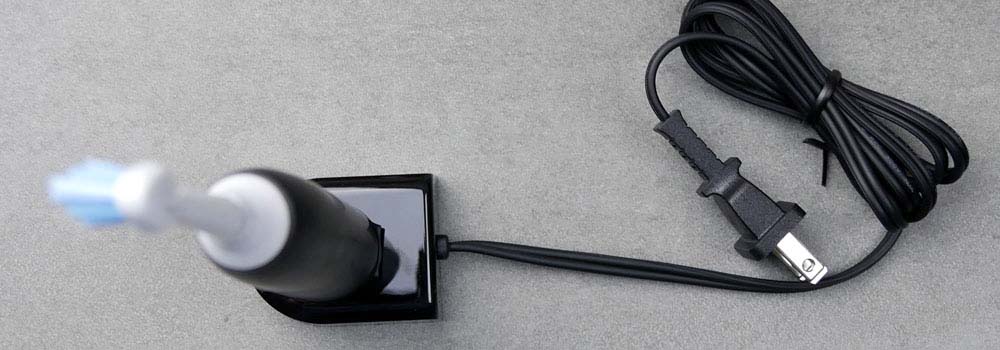
At the top of the brush handle is the metal shaft that the brush head connect to. This metal shaft feeds into the motor sealed inside the handle.
Analyze the brush side on and you will see how the brush head fits on at a very slight angle.
Slight it might well be, but it helps angle the brush head for a better reach towards the back of the mouth. A subtle, but important design feature that enhances the overall usability.
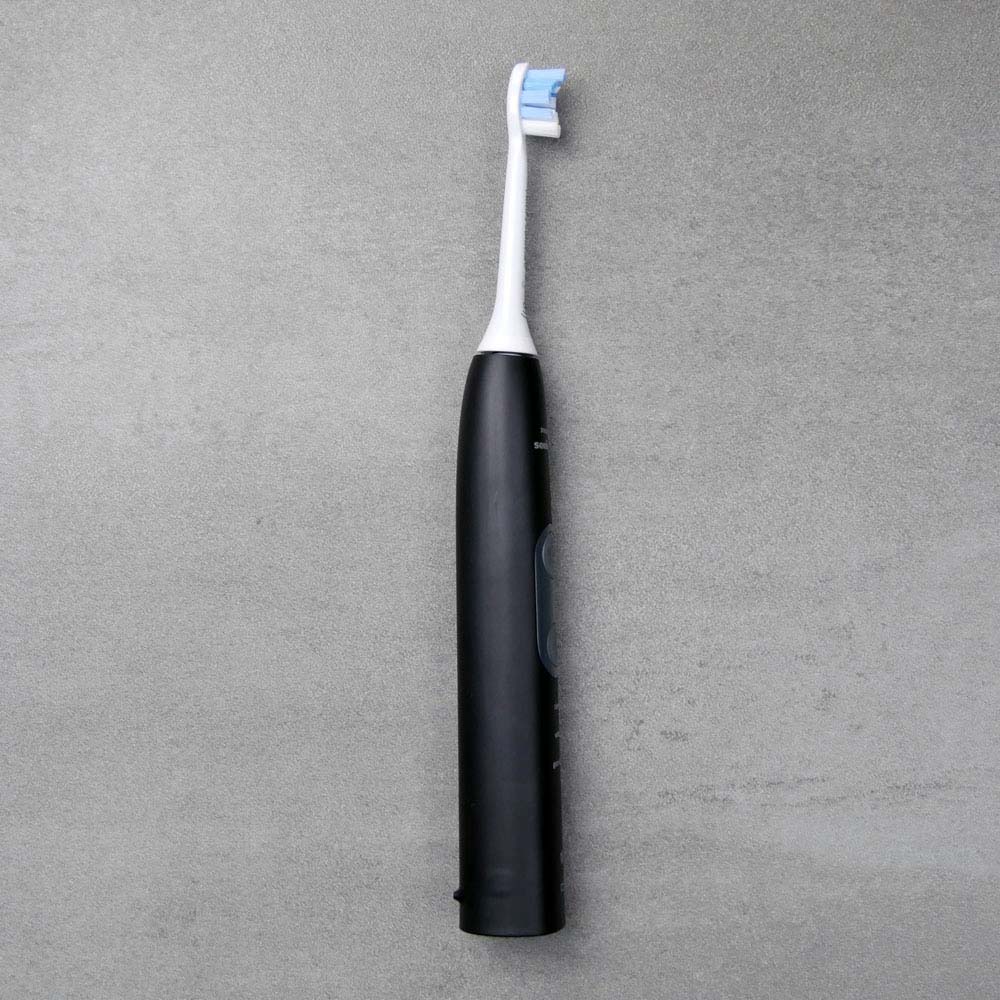
The 5100 comes with 1 x G2 Optimal Gum Care brush head supplied in the box.
This is just 1 style, from a range of interchangeable brush heads that Sonicare offer. We cover brush heads in more detail in our guide to Sonicare brush heads.
Fitting the brush head is a simple process
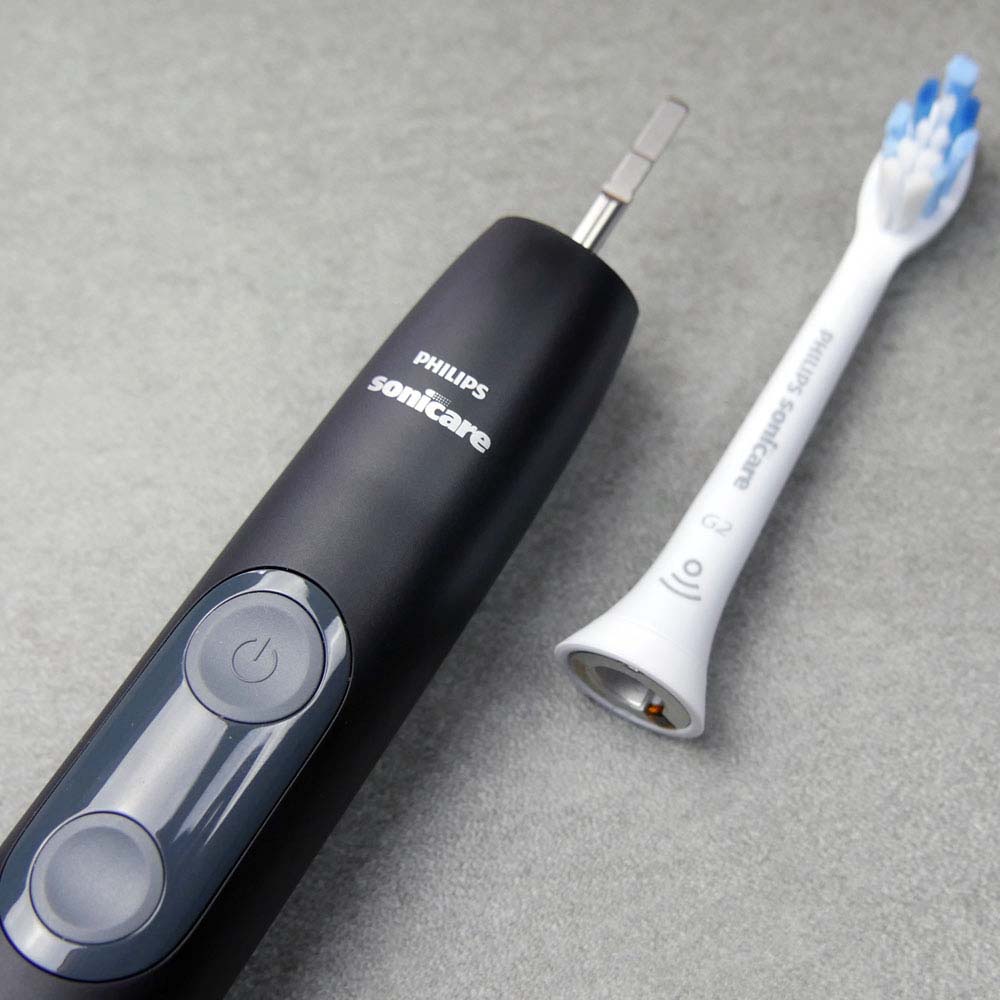
Each brush head simply pushes on and pulls off of the brush handle. The heads fit over the metal shaft at the top. You can usually feel it clip into place.
Almost all brush heads are interchangeable and work on almost all Sonicare brush handles, so you can find the brush head that works for you or that you prefer and use it on your brush handle.
But, with the 5100 there is something you need to be aware of.
The ProtectiveClean has a feature called ‘BrushSync’. What this does is tells you, via an LED on the brush handle when it is time to change or replace your brush head.
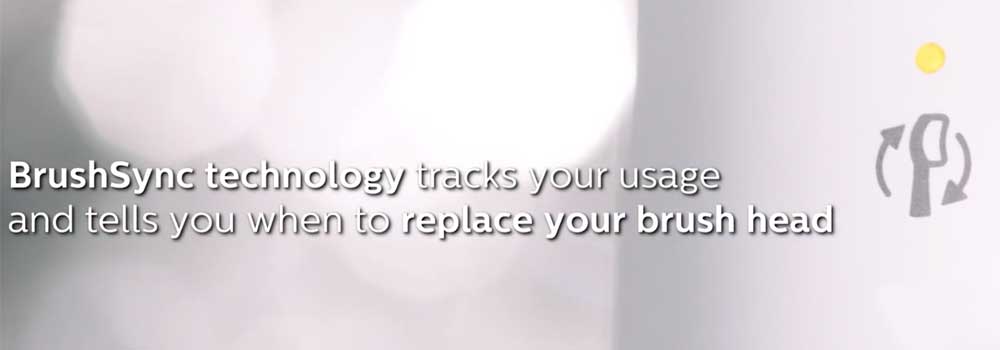
You see, inside the brush head supplied is a small microchip.
When the brush head is fitted to the brush handle, the chip is detected and the warning light will flash 3 times. This acts as confirmation that the handle has detected the head and that the electronics inside the handle will now keep track of it.
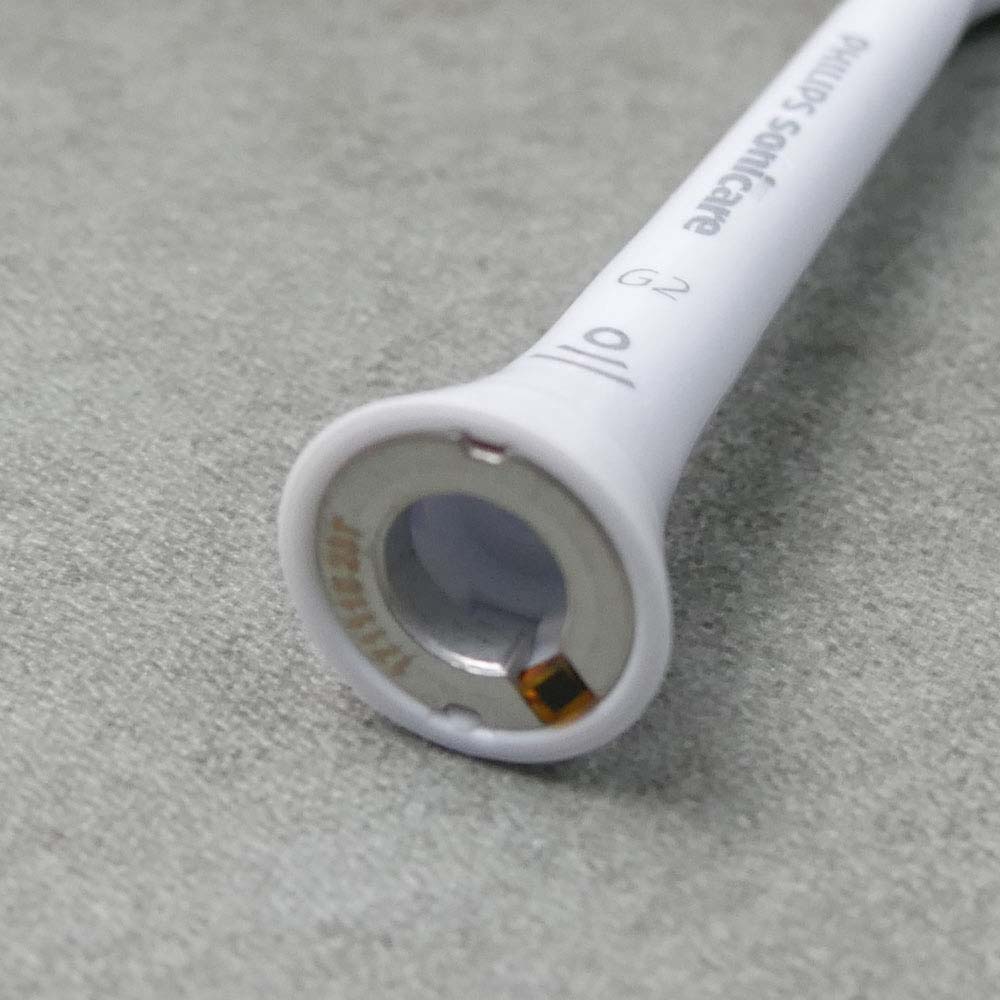
As you use the brush head, the handle continues to track how often it has been used.
The handle knows that the brush head should be replaced every 3 months, so once the handle detects that the brush head has been used for this amount of time, the ‘BrushSync’ LED on the brush handle will light up an amber/orange color. It is at this point you should fit a new head.
But, the brush is cleverer still.
If it detects you have brushed 3 times a day every day or brushed with more pressure, it will activate the BrushSync alert system sooner, as the bristles will have worn out sooner than the typical 3 month time period.
By the same token, it will delay alerting you to replace the brush head. If you used that head just once a day over 3 months, it would not tell you to replace it until it had been used for an equivalent to 4 minutes a day for 3 months.
Hard not to be impressed!
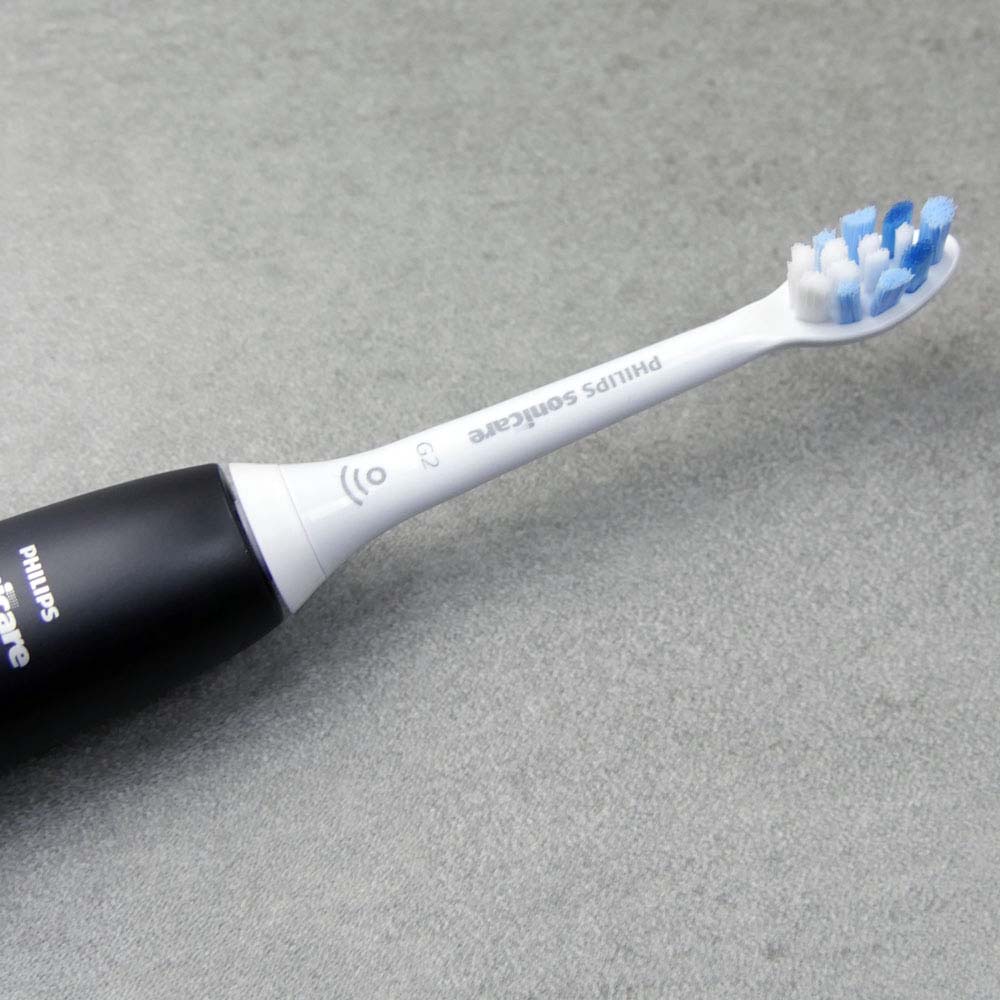
Using a brush head for longer than 3 months can potentially have negative effects on the teeth and gums, so such an alert helps reduce the chances of this.
Technology such as Bluetooth connectivity found on some brushes is not for everyone. Not all that many see the point, but I think most people see the point here.
The sensors are smart, unobtrusive and are only trying to help you take better care of your teeth and gums.
Now here perhaps is the kicker when it comes to this tech.
Not all the brush heads Sonicare make have the microchip built-in.
So for it to work, both the brush head and brush handle have to have the ‘BrushSync’ feature.
At the time of writing the heads that have the chips built-in and are BrushSync compatible are:
- I Intercare
- C2 Optimal Plaque Control
- G2 Optimal Gum Care
- W DiamondClean
- C3 Premium Plaque Control
- G3 Premium Gum Care
- W3 Premium White
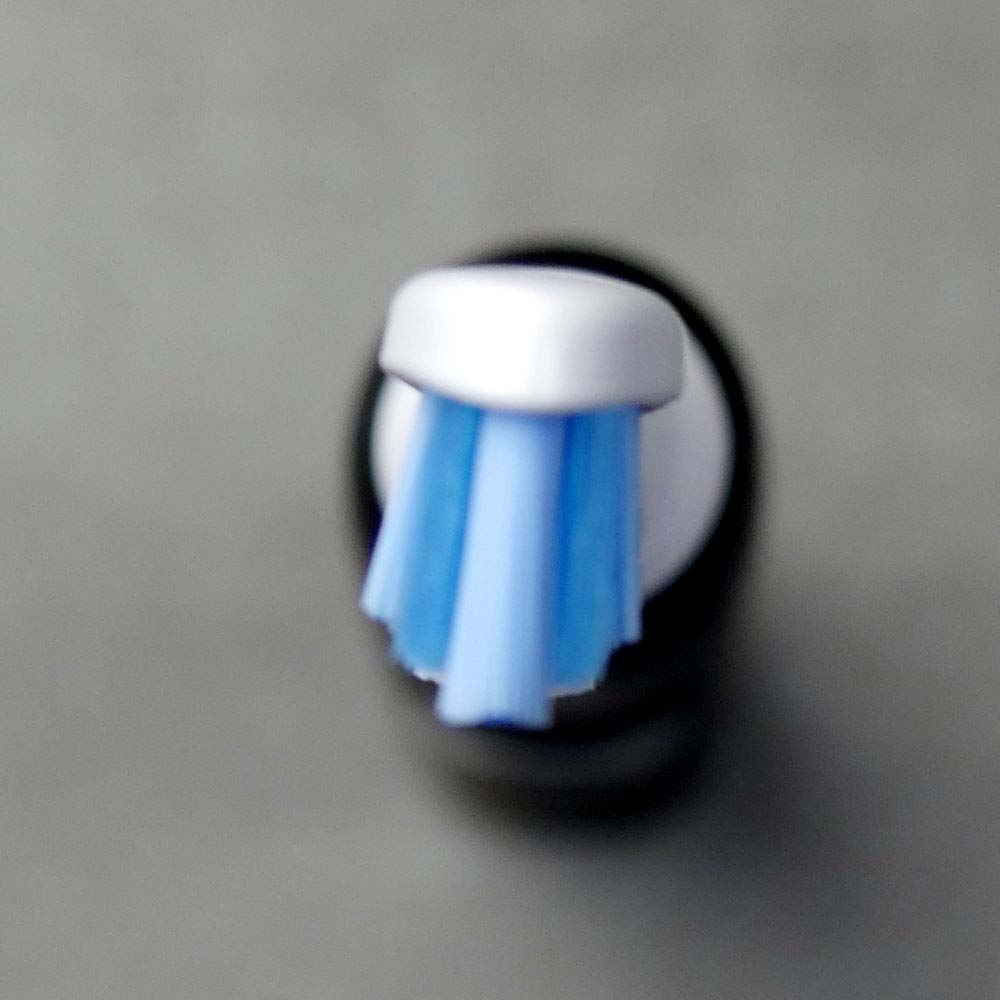
There are then a series of what I call ‘standard’ brush heads that are similarly named but do not have the microchip in.
The options you have are:
- DiamondClean
- AdaptiveClean
- InterCare
- ProResults
- ProResults Gum Health
- Sensitive
It is perfectly possible to use a non-smart (standard) brush head on the 5100 as it is perfectly fine to use a smart brush head on a handle that does not offer BrushSync technology. But, do be aware, the BrushSync will only work when a compatible head is used on a compatible handle.
Such technological advances don’t come for free.
Since they were first introduced in 2017, the price has reduced a bit already, but the BrushSync compatible heads are a little more expensive than the standard alternatives.
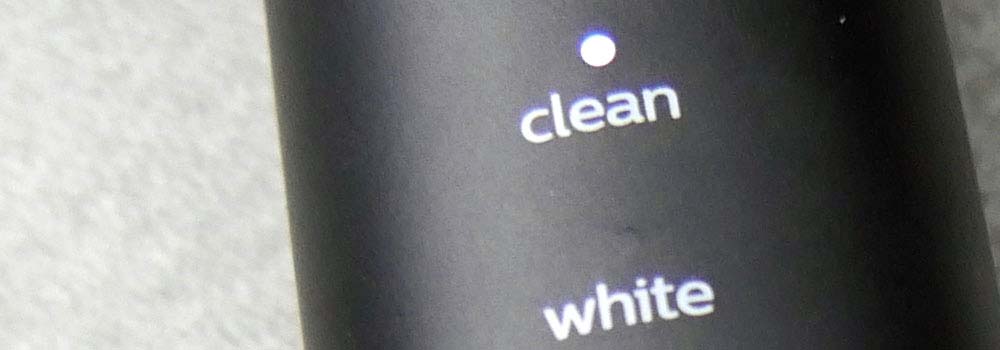
Prices vary from one store to another. I have found them as low as $8 per head, but as high as $15.
An average price is around $12.
A normal brush head for a Sonicare electric toothbrush is on average $8.
You are then paying for this convenience, but I think it is probably a convenience worth paying for.
In line with the electronic brush head replacement reminder that the ProtectiveClean 5100 offers, there is actually a reminder system built into ALL Sonicare brush heads.
Each head has fading indicator bristles.
As the heads are used, the Blue bristles fade to a very pale almost white/translucent color. When they are this color, it is time to change the head.
It is like a simplified alternative to BrushSync.
The brush heads are not the only clever part of this electric toothbrush.
Essential to any good brush is a timer and quadpacer, in my opinion. You will then be pleased to read that the 5100 has both.
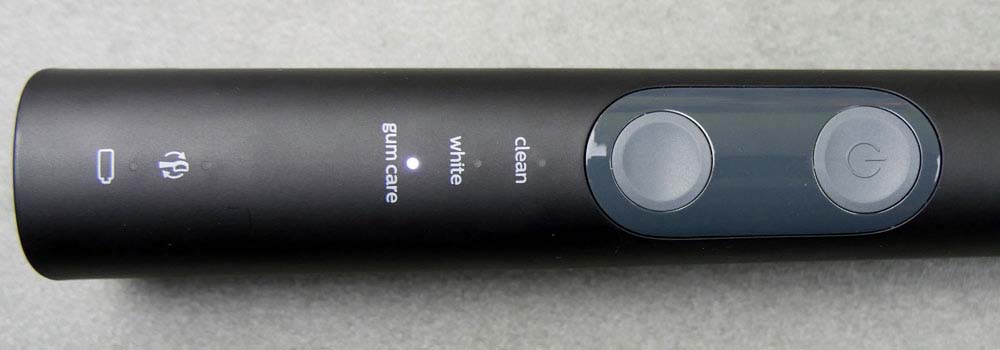
A simple press on the power button will turn the brush on. As the motor is kicked into life, the timer is too.
Using the standard ‘Clean’ mode the timer runs for 2 minutes, which is the dentist recommended cleaning time.
At the end of the 2 minutes, the brush actually turns itself off.
The 'White' mode runs for 2 minutes and 30 seconds, whilst the 'Gum Care' mode lasts for 3 minutes.
The brush does turn itself off at the end of these cleaning modes too.
At the same time, the timer begins working, as does the 30 second timer or quadpacer as it is known.
During the standard cleaning cycle, at 30 second intervals, the brush motor pauses briefly.
This stops the cleaning action and pauses the humming sound and vibration from the handle.
It is this pause that alerts you to the fact that it is time to change quadrant.
Whilst dentists recommend 2 minutes of cleaning twice a day, what this does not help with is ensuring you and I brush our teeth evenly. This is where the pacer comes in.
The idea is that you break the mouth up into 4 sections. Upper right, upper left, lower right, and lower left.
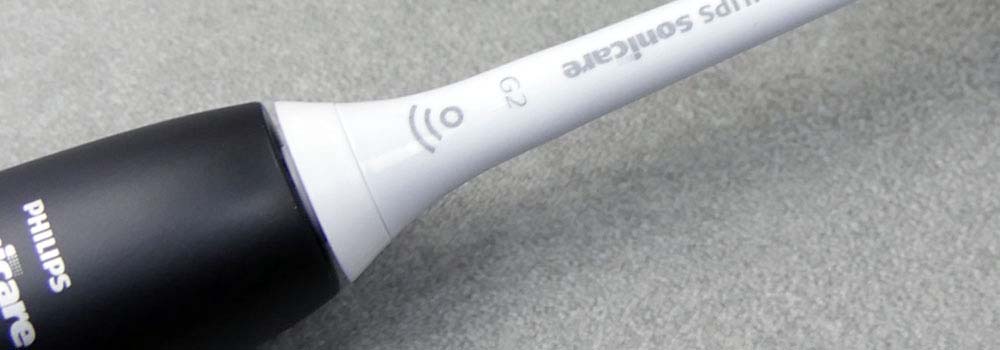
You spend 30 seconds cleaning each section, that way over the 120 seconds (2 minutes) of brushing time, you will give a relatively even clean to the teeth and gums.
As you get the pacer alert, you change quadrant to in turn achieve the even clean.
Of course, you don’t have to follow it, but it is good practice.
Spending 2 minutes cleaning just the front teeth or just your top teeth is better than nothing but isn’t great for your oral health.
Therefore the 2 minute timer and 30 second pacer are 2 excellent additions to this handle.
If you use the 'White' or 'Gum Care' mode, the pacer still functions for the first 2 minutes of cleaning only. The remaining 30 seconds for 'White' and 1 minute for 'Gum Care' are for focusing on the front teeth and gums respectively.
Electric toothbrushes bring multiple benefits over and above regular toothbrushing.
However, the superior clean they can offer is only achieved when you use the electric brush correctly.
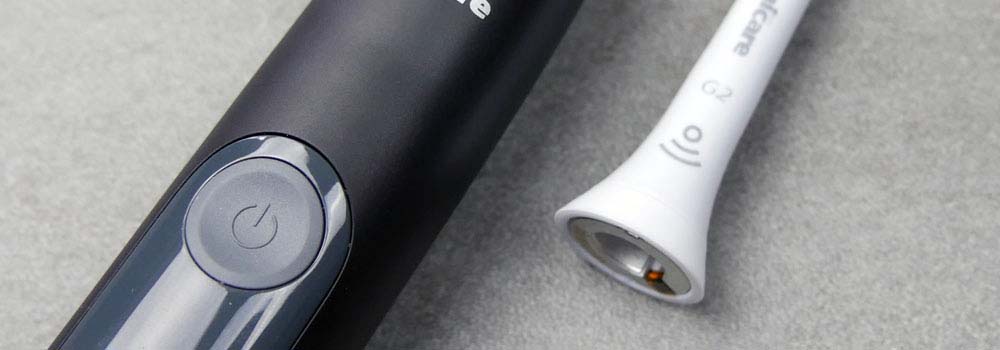
You should not move the brush head back and forth in a rapid manner as you might with a manual brush. You move the head from tooth to tooth, the motor and bristles do the work.
You should to hold the brush head at a 45 degree angle to the teeth and gumline.
Refer to the instruction booklet that comes in the box with the ProtectiveClean and spend time learning how to brush your teeth correctly. Get this right and you are really helping yourself achieve better oral health.
Irrespective of the cleaning mode used, I have been very impressed with the results and overall performance of this brush.
At no point have I felt the clean to be bad and certainly comparable to Oral-B.
There is clinical evidence that sides with both brands, but the reality of the situation is either are very good.
Personally I prefer the smaller, round brush heads that Oral-B offer compared to the larger more rectangular/ovalish heads of Sonicare. I find them easier to move around the back teeth.
'Clean' is, of course, the standard go to mode, which runs for 2 minutes, but you have 'White' and 'Gum Care' too.
You need to press that function button to select the appropriate mode.
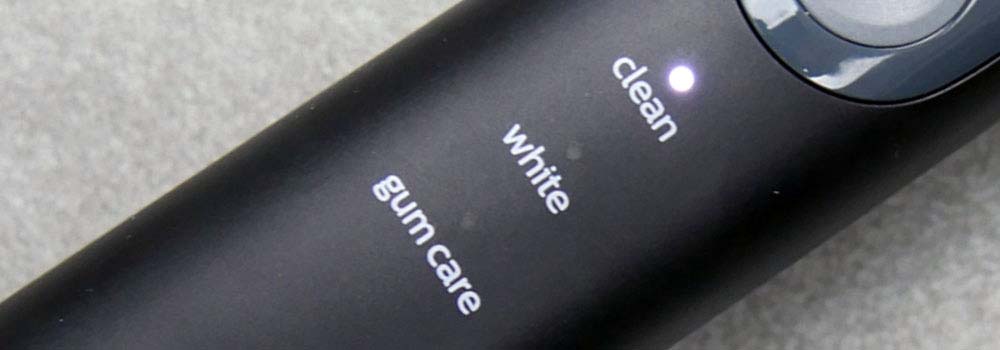
Sonicare explain the modes as follows:
- Clean mode
- A 2-minute mode. It gives you a thorough and complete clean and is recommended to be used with the C2 Optimal Plaque Control brush head.
- White mode
- A 2-minute 30-seconds mode. 2 minutes for normal cleaning and 30 seconds to polish the front teeth. Recommended to be used with the W2 Optimal White brush head.
- Gum Care
- A 3-minute mode. 2 minutes of normal cleaning and 1 minute to clean and stimulate the gums. Recommended to be used with the G2 Optimal Gum Care brush head.
We cover all of Sonicare's cleaning modes in more detail in this post in this post
You can see where the different styles of brush heads mentioned previously can come in use and be helpful in achieving optimum results.
The motor in the brush handle offers up to 62,000 movements per minute.

The 'Gum Care' mode is more gentle and does not make use of the full power like the 'White' and 'Clean' mode do.
Gum disease sufferers or those with generally sensitive teeth will be thankful for the lower powered, less intense clean that the 5100 offers.
As bristles need only skim the surface of the teeth to dislodge bacteria, plaque, and food debris, lots of force is not required to brush the teeth clean.
Brushing too hard over long periods of time can wear out brush heads but also cause gum recession and damage to the tooth enamel.
This is why the 5100 has a pressure sensor built-in.
The handle vibrates to alert you when too much pressure is being applied, the brushing sensation and sound changes too.
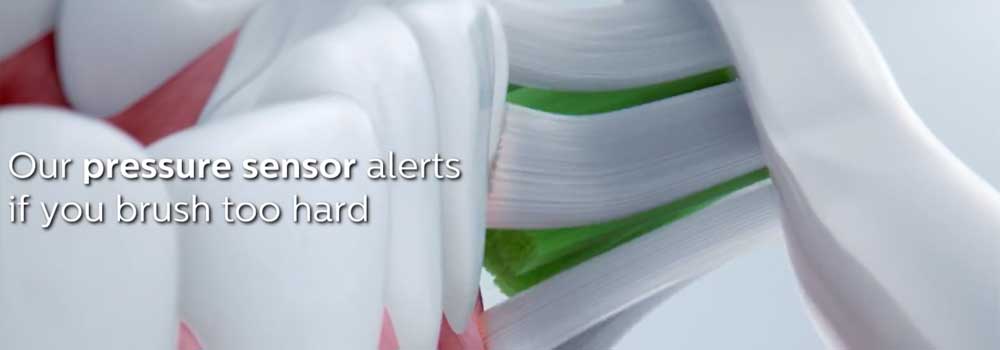
The BrushSync replacement reminder LED flashes amber when the sensor is activated. Given its position, it is not the easiest to see.
It does not have the large visible pressure sensor like the Oral-B Pro 3000 and Sonicare’s own DiamondClean Smart.
Personally I do think the light it more obvious, particularly when most of us tend to brush in front of a mirror. Sadly, the flashing amber light is on the wrong side of the handle for you to really notice, but you should feel the change in brushing sensation.
However, the vibration is strong enough to make you aware it has been activated.
Reduce the pressure applied to stop the pressure sensor from being activated. The sensor will kick in every time too much pressure is applied.
Seasoned electric toothbrush users may know how much pressure is appropriate. I believe it is more useful to first time or new users, but I am sure there are some electric toothbrush uses that brush too hard.
Within a few days, you will get used to how much pressure is appropriate.
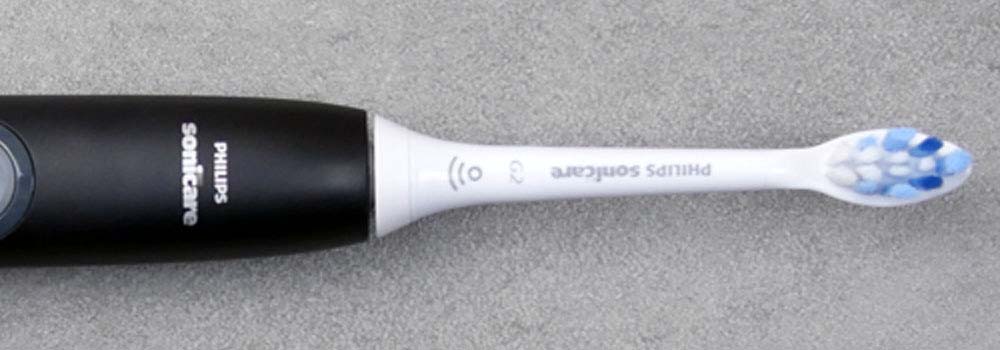
Another great feature is something known as EasyStart.
This is a system that gently increases the power over the first 14 brushings to help you get used to brushing with the ProtectiveClean 5100.
A simple, but innovative touch that shows an extra level of attention and care for first time electric toothbrush users. The full 62,000 movements per minute can seem quite intense on first use. EasyStart eases you in and makes the transition from manual to electric brushing easier.
If you want to go straight in with full power you can turn the EasyStart off. How you do this is explained in the FAQ’s at the end of this review. It is possible to turn off the pressure sensor and brush head replacement reminder system too.
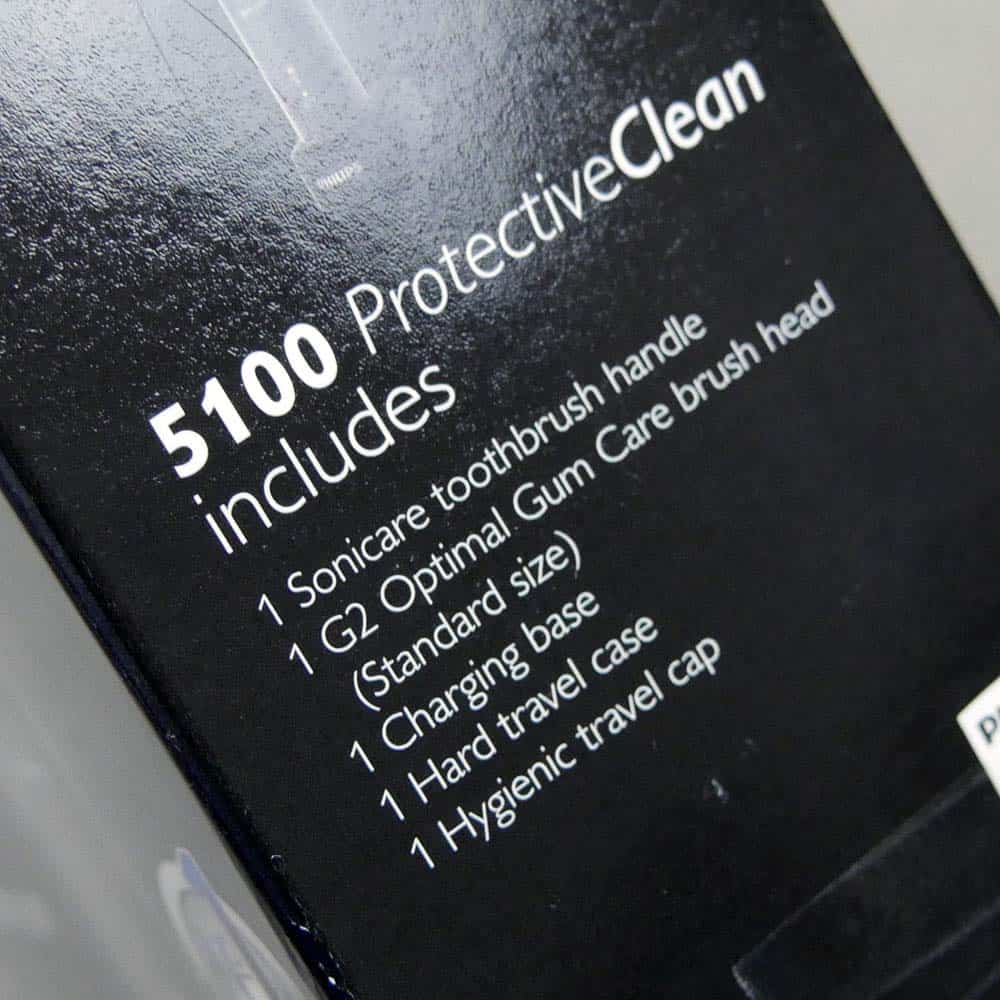
Fixed inside the handle of the 5100 is the rechargeable Lithium-Ion battery that offers about 2 weeks usage between charges, Sonicare suggest. I actually achieved 20 days just shy of 3 weeks on the longest mode, 'Gum Care'.
Thankfully, the battery charge LED provides feedback on the remaining power, so you know when a charge is necessary. More information is available in the ‘Battery Life’ section of this review.
Designed to resist water, toothpaste, and saliva, the handle of the 5100 is not designed to be used in the shower or the bath. A quick rinse of the handle is fine, but don’t go immersing it in water if you can help it.
The handle feels robust and will generally take a few knocks in its life and I have no immediate concerns about the handles reliability.
Sonicare do offer a 2 year warranty that covers any mechanical or workmanship faults, but not user damage. For your own benefit, go register it shortly after purchase, you get a 6 month extension.
A complaint I had about the ProtectiveClean 4100 was the lack of a travel case. This comes provided with the 5100. Ok, you do pay for it, but in my opinion, it is more handy than you might think at first.
Black or white in color, it is matched to the brush handle.
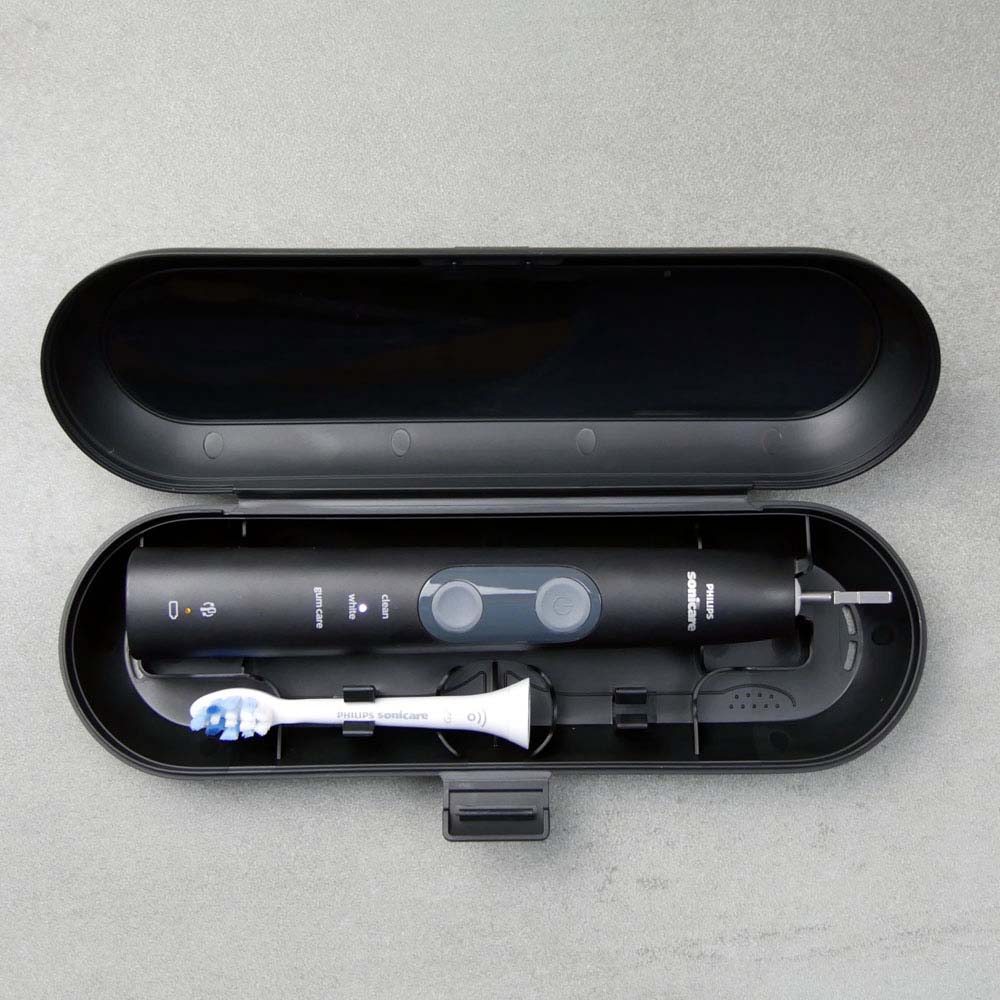
Made from a thick plastic, the case is hinged on the left side with a clip on the right to securely fasten it shut.
The case holds the 5100 brush handle and up to 2 brush heads.
Not only will it stop the handle or heads getting damaged, it also stops any accidental activation of the brush.
The 5100 is a very solid brush overall.
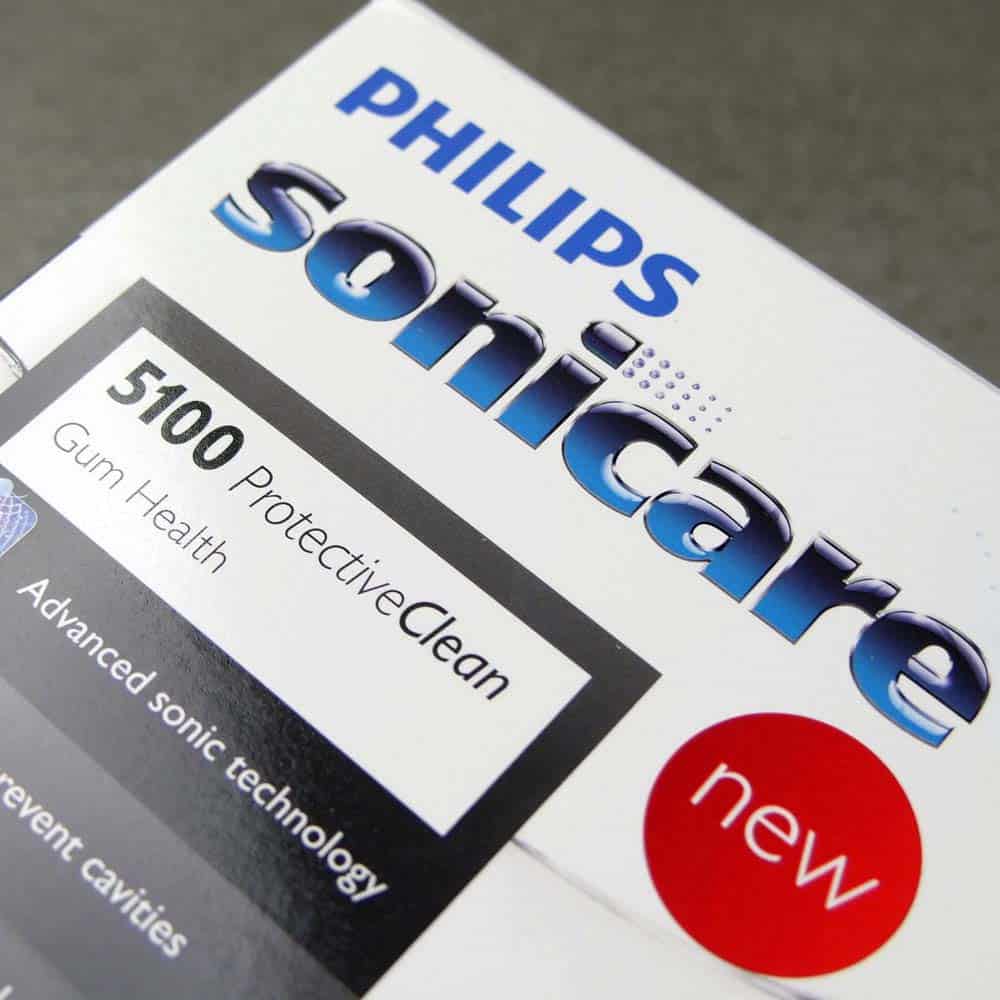
It comes at a price premium over the 4100, but does offer the travel case and extra cleaning modes.
The extra modes will be desirable to some, but not all.
I believe those with sensitive teeth and gums will find the 5100 to be a good buy as you benefit from that 'Gum Care' cleaning mode.
Oral-B’s equivalent offers Bluetooth connectivity, similar to the Sonicare FlexCare Platinum and DiamondClean Smart. You can log and track your clean through a smartphone app.
Such a feature is clever, but I have seen mixed feedback from users on just how useful it is and how often they use it.
Given the 5100 offers a travel case, double the battery life and BrushSync, I think the 5100 is the better buy.
Sonicare have done a great job with the 5100. Whether you are a new or existing electric toothbrush user you will be impressed.
Summary of design, usability, clean & general use
Battery life
Some Sonicare models boast a battery life of 3 weeks, which I think is fantastic, but such usage time is generally available only on the most premium models.
The ProtectiveClean 5100 offers a respectable 2 weeks of use between charges or so Sonicare claim.
Compare this to Oral-B’s 7 days or 28 minutes of usage time and the 5100 looks pretty appealing with double the usage time.
If you are away for a few nights or even a couple of weeks for business or pleasure, you simply need not worry about taking the charging stand with you.
On the front of the brush handle, is a battery/charging icon, this gives you some important feedback on the remaining charge within the built-in lithium-ion battery.
- A solid green LED means a full battery.
- A flashing green LED means a medium battery.
- A flashing amber LED and three beeps mean a low battery.
- A flashing amber LED and five beeps mean no brushing sessions left, you need to charge the toothbrush.
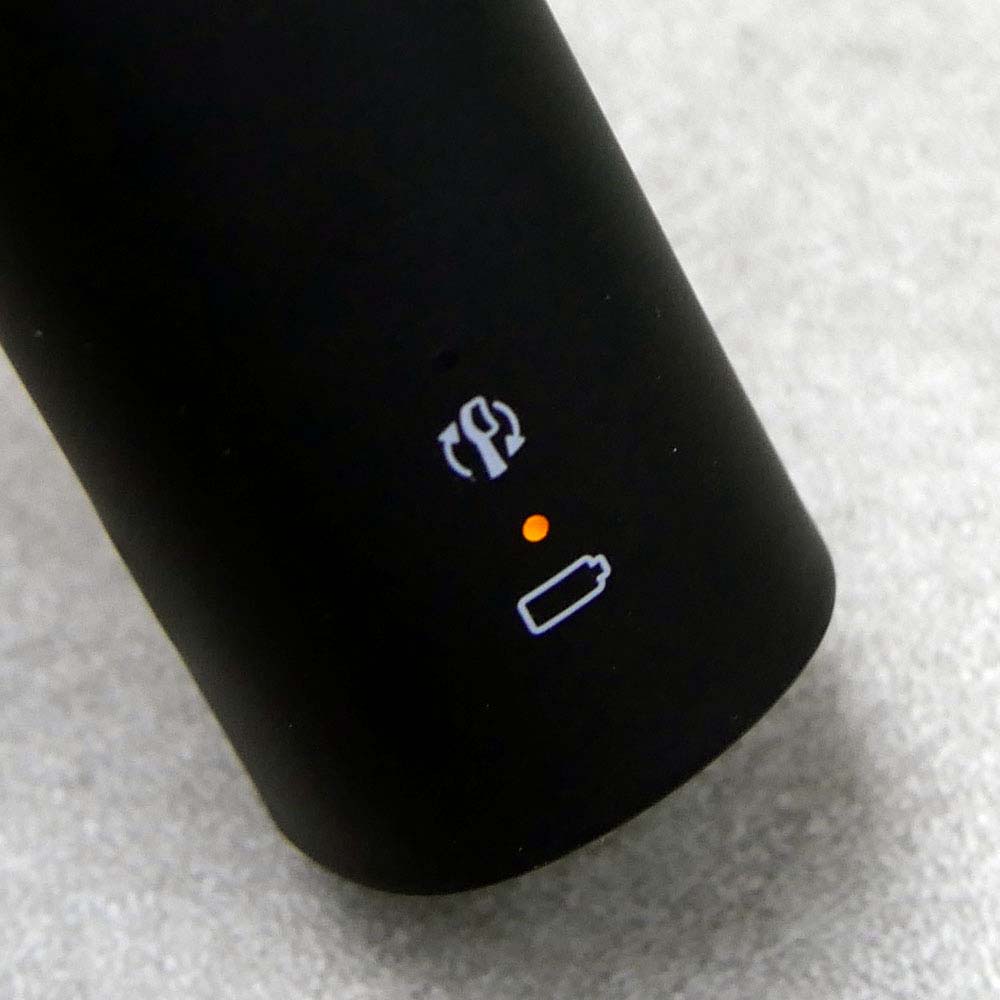
Influencing the number of days you get out of the battery, is the cleaning mode used.
The 5100 has 3 different cleaning modes that last for different lengths of time.
The 'Clean' mode on the 5100 lasts for 2 minutes, but 'White' mode lasts for 2 minutes 30 seconds and the 'Gum Care' mode, 3 minutes.
I said Sonicare claim a 2 week battery life, but my own hands-on testing achieved 20 days, just shy of 3 weeks with the longest running 'Gum Care' mode and a staggering 37 days, or 5 weeks with the 'Clean' mode.
This extra battery life is great! I like how Sonicare underpromise and over deliver, but even by their standards they are outdoing themselves here.
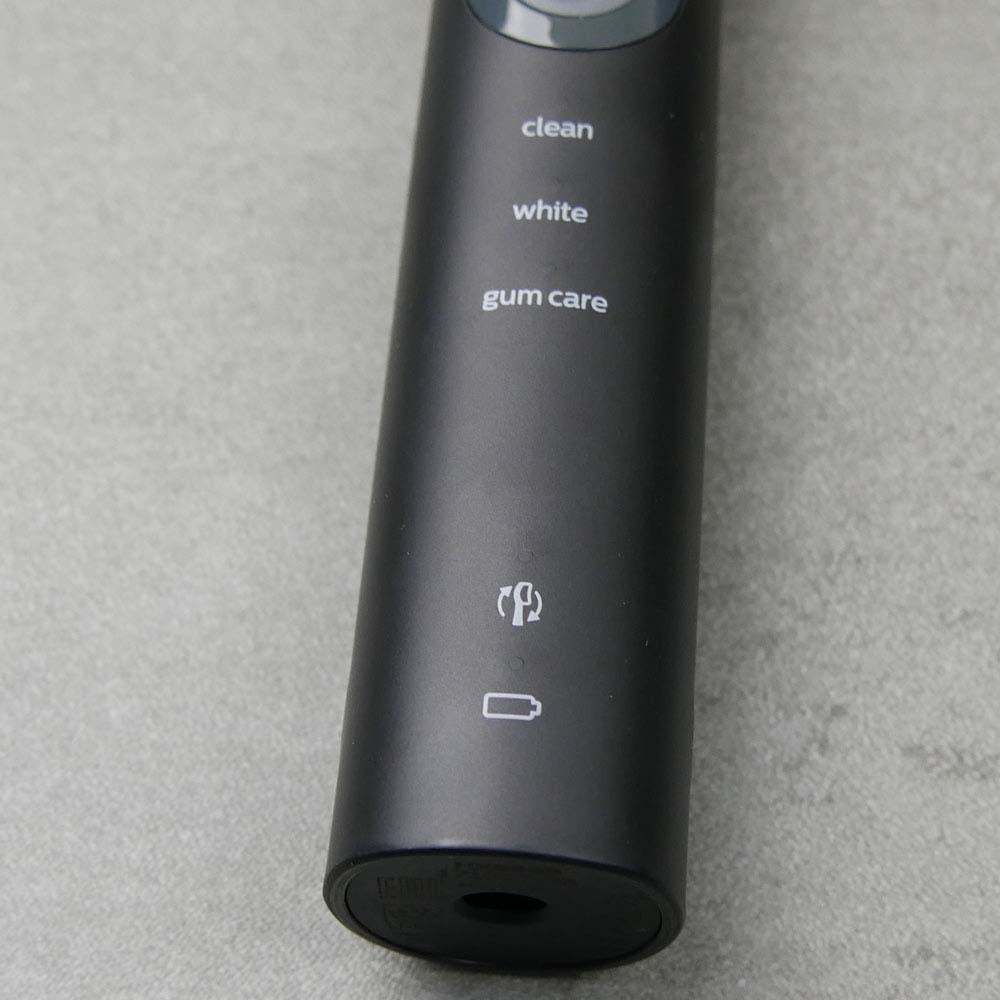
When the battery is in need of replenishment, you can use the charging stand that is provided in the box.
This is actually color matched to the handle. So, you get a white stand with the white & mint models and a black colored stand with the black gray variant.
The 5100 sits on top of this charging stand. A prong on the stand fits into the recess, on the base of the brush handle.
Once placed on the charging stand, the charger will emit 2 short beeps to confirm that the handle is placed properly.
The flashing light of the battery level indicator shows that the toothbrush is charging. When the handle is fully charged, the battery light shows goes a solid green for 30 seconds and switches off.
It can take up to 24 hours to charge the handle fully.
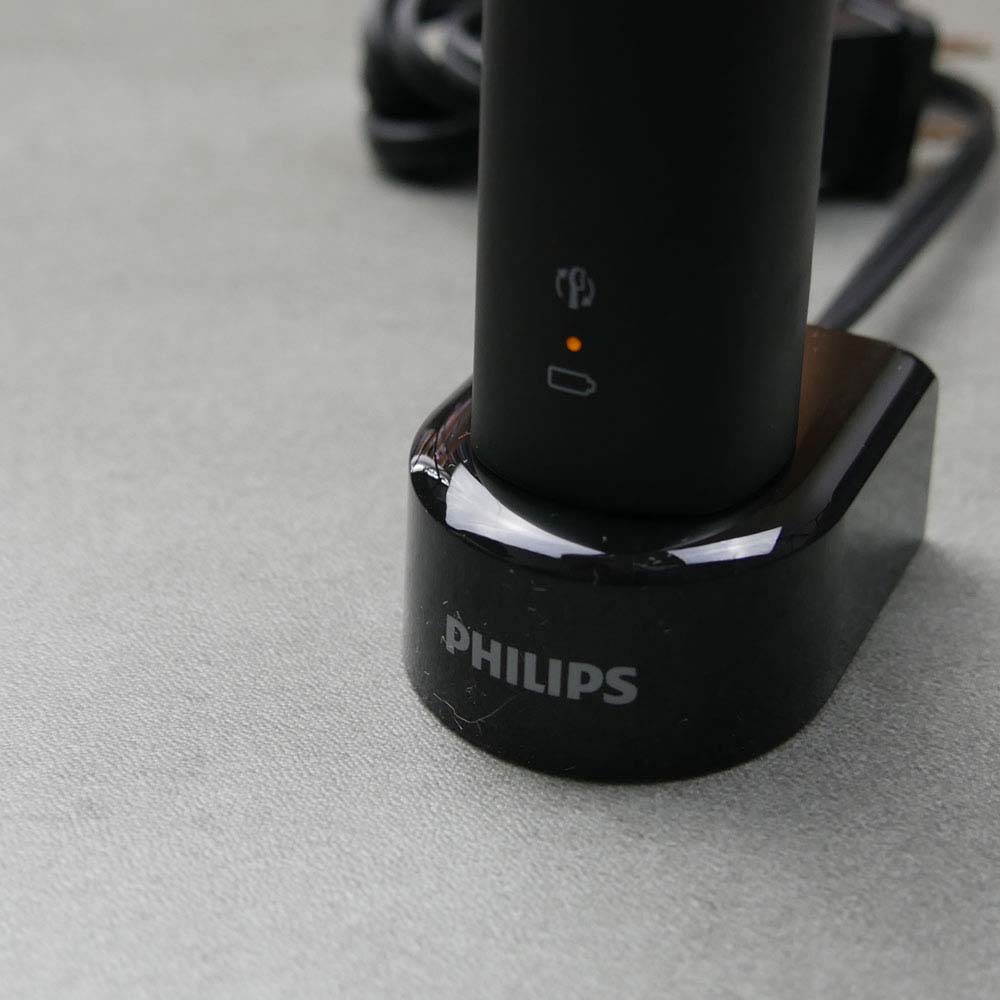
A US power adapter is wired into the stand, but it does support 100-240v.
What this means is that you can actually travel to other countries, like those in Europe and use this charging stand. You will require a plug adapter only and not a voltage adapter.
Generally speaking, it is ok to leave the brush sat on the charging stand when not in use. It is perfectly fine to keep the battery topped up,
But, good practice is to let it run down a little and not constantly be fully charged. To avoid doing any potentially long term damage to the battery, keep it unplugged unless it needs charging.
The Lithium-Ion (Li-Ion) cell sealed inside the handle is not user removable. It is more efficient and reliable than the Nickel Metal Hydride (NiMH) cells that have been used in many toothbrushes in the past.
Good performance on the battery front from the 5100.
Summary of battery life
Price & where to buy
I have included links to buying options here at the start of the review.
In the section below, I discuss the price more generally and in relation to similar products.
Every manufacturer sets or has a suggested retail price for their products.
This is the price that they feel it is worth based on what it offers and how it compares to other products available on the market.
As a general rule, Sonicare tend to have a higher retail price than their major competitor Oral-B; particularly at the higher end of the market. This has been made more noticeable by the ‘discounts’ offered. Where there might be 20-30% off Oral-B, Sonicare models are subject to well under 20% discount in many instances.
Over the last few years, the price difference has been getting smaller, particularly with mid range models like the 5100 here.
Quite honestly, comparing the 5100 to its Oral-B counterpart to say which is better value is very difficult, they both have compelling features, but in my mind Sonicare now has the edge.
The ProtectiveClean 5100 has a suggested sale price of $99.99.
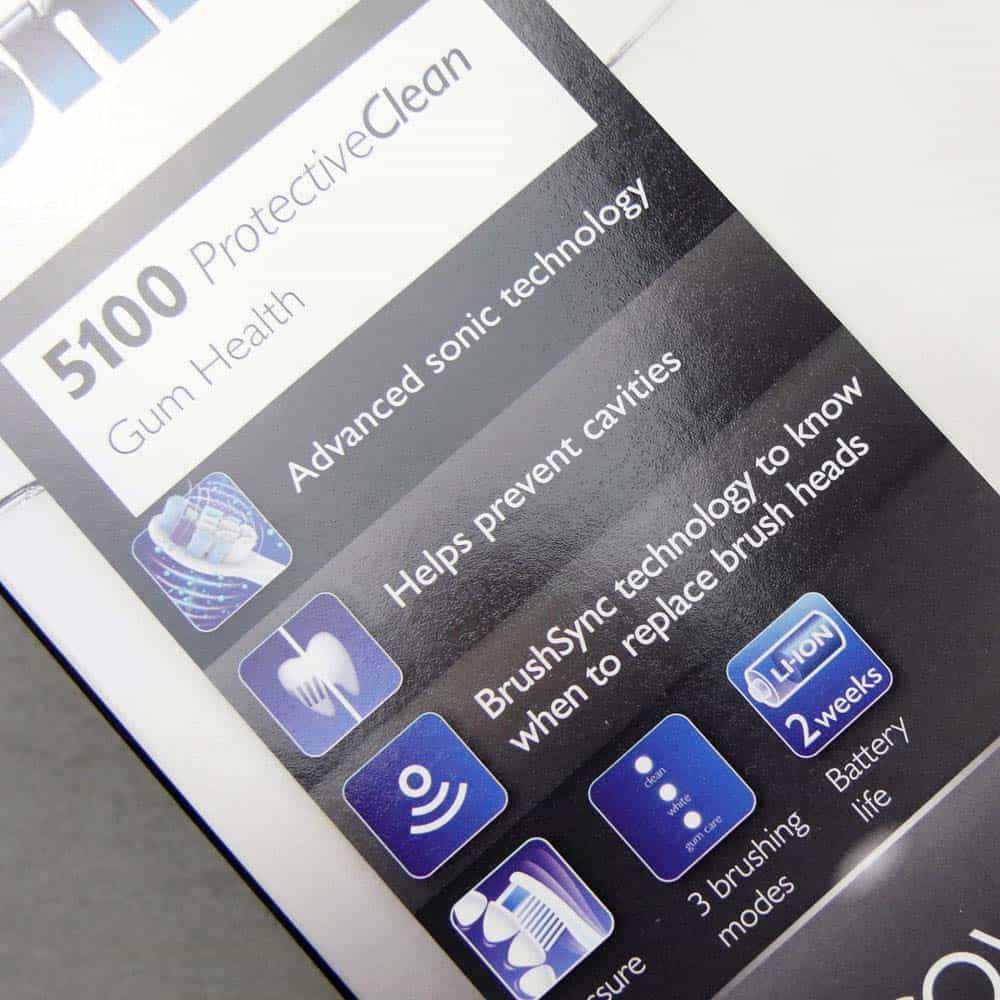
Do not go expecting big discounts, but just several weeks after launch, $95 seems to be the going price for this model.
$5 off, it is a saving, even if not as big as we might like.
Available from Fry’s, Walmart, Best Buy, Target, and Amazon, you have some choice as to where you buy it from - we have listed a few buying options here.
Sonicare’s 4100 is about $20 cheaper than the 5100, but does not come with a travel case and extra cleaning modes, which I do believe to be worth the extra $20 spend if you agree you will make use of such extras.
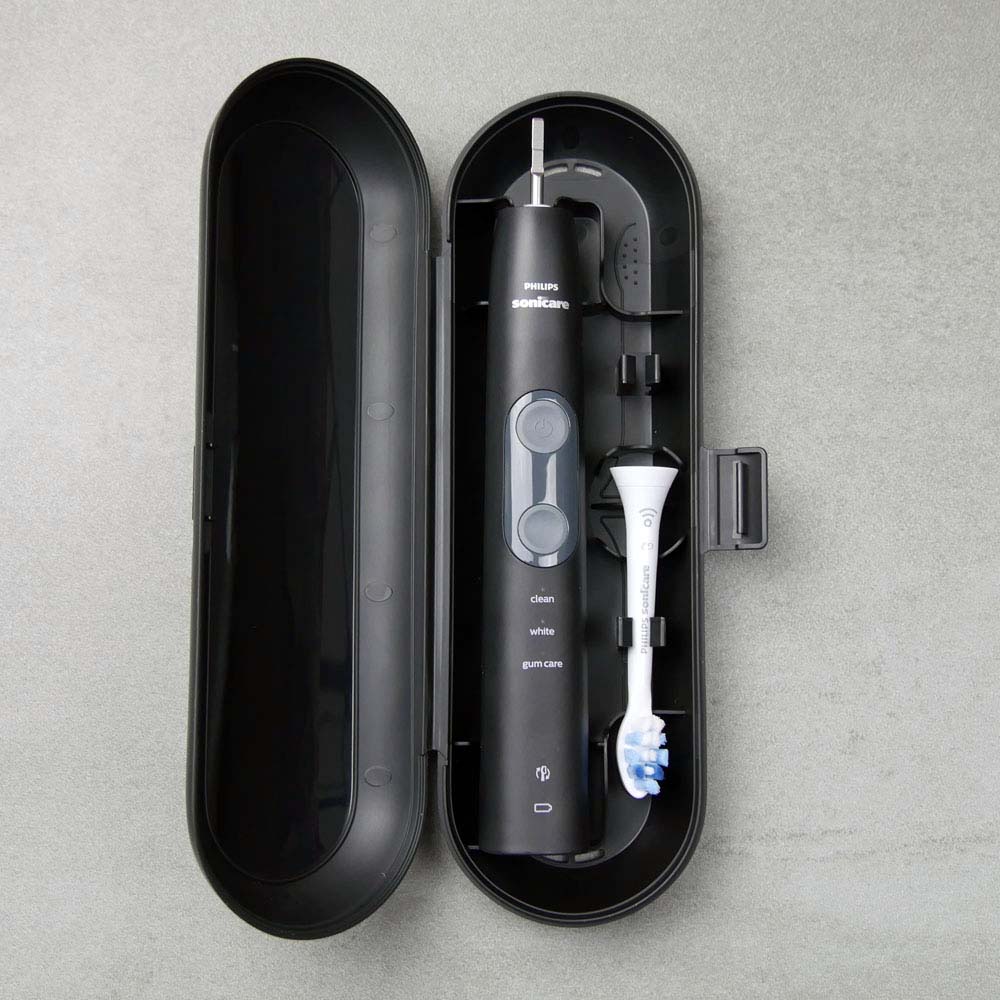
A potential downside, for the time being, is the ‘BrushSync’ feature does mean that compatible brush heads are a little more expensive.
A single ‘BrushSync’ compatible head can cost as much as $15 each or as little as $8 per head.
As an average, you can expect to pay $10.
Whilst this might not be huge price difference, over the course of several years, you will be surprised how much you can save by shopping smart for brush heads. You could be looking at best part of $50 back in your pocket!
I would advise you bulk buy the heads when the price is low to get the best deal.
As Sonicare launch more models with BrushSync, I am convinced the price will come down.
In fact, these heads were first introduced in 2017 with the launch of the DiamondClean smart and the average price has already dropped a little.
A typical working life of an electric toothbrush is normally 3-5 years. Many will in fact, last a lot longer, with good care.
To try and give some sort of gauge for overall ownership cost, here at Electric Teeth, we like to price the brush over a 3 year period to give a benchmark and allow comparison to other brushes.
So what does the 5100 cost to own?
With a $95 purchase price, plus the cost of 11 replacement brush heads over 3 years, you are looking at a total cost of $205.
All told, this is not a lot of money when you consider what the brush offers, most notably the excellent clean to your teeth and gums.
Investing in such a brush and using it correctly, might actually decrease your dental bills.
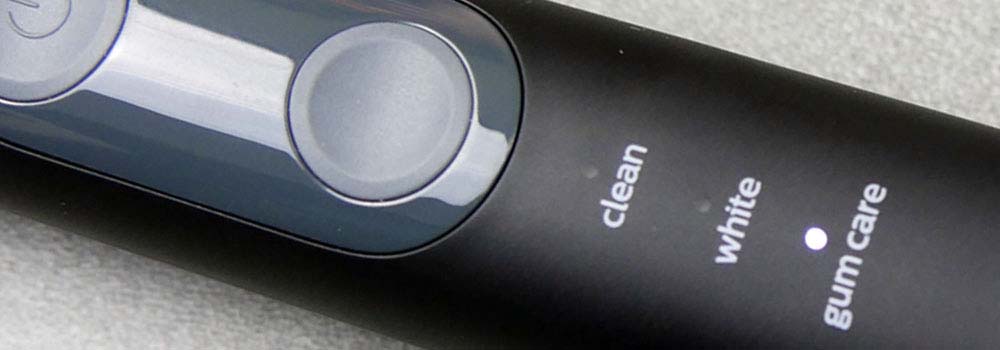
Please note that all prices quoted are approximates and will vary based on location, supplier and time of purchase. These figures were correct at the time of writing and should not be relied upon as hard fact, but used as a guide during your decision process.
Summary of price & where to buy
Reliability & long term use
Any electric toothbrush that is reviewed by Electric Teeth is assessed as best as possible to look for possible reliability and performance issues.
Not completed by any specialist equipment, it is done by eye and making comparison to the many other brushes we have used.
Our experience allows me to say, that whilst there is always the potential for something to go wrong, (there are electrical circuits built-in) the build quality and performance I have experienced gives no cause for concern.
The brush feels solid and well built-in hand as is typical of a Sonicare product.
Added peace of mind comes from the 2 year manufacturer warranty, provided as standard when you buy the 5100 new. Register it shortly after purchase and you can extend it for an extra 6 months for free.
Conclusion
When it comes to choosing an electric toothbrush, there is a lot of choice, so picking the right one for you can be difficult.
There are a few ‘essential’ features in my eyes that all brushes should have. I am pleased to say that the 5100 comes with these and a few more.
A solid performing brush, there is little to dislike here.
Unless you are brand conscious, the Smart 1500 from Oral-B is a good value purchase.
If you prefer Philips and don't need or want extra cleaning modes or a travel case, you could save a few dollars and opt for the 4100 Series, but the extras provided here come at a justifiable premium.
I have little issue in recommending this electric toothbrush.
Size guide
- Toothbrush height with head - 25cm / 9.8 inches
- Toothbrush height without head - 19cm / 7.5 inches
- Width - 2.8cm / 1.1 inches
- Depth/thickness - 3cm / 1.1 inches
- Weight with head - 130g / 4.6oz
- Weight without head - 125g/ 4.4oz
- Travel case size - 21.2cm / 8.34 inches (L) x 7cm / 2.8 inches (W) x 4cm / 1.6 inches (D)
- Travel case weight - 84g / 3oz without brush or 214g / 7.5oz with brush
- Package weight - 470g / 16.6oz
Noise
- 59dB
Country of manufacture
- China
FAQ
How to turn on and off EasyStart
- Put the handle on the plugged-in charger.
- Press and hold the power on/off button while the handle remains on the charger.
- Keep the power on/off button pressed until you hear a single short beep (after 2 seconds).
- Release the power on/off button.
- Triple tone of low-med-high means the EasyStart feature has been activated.
- The brush head replacement light and battery light will also blink green 3 times in unison to confirm activation.
- Triple tone of high-med-low means the EasyStart feature has been deactivated. The brush head replacement light and battery light will also blink amber 3 times in unison to confirm deactivation.
How to turn on and off brush head reminder
- Put the handle on the plugged-in charger.
- Press and hold the power on/off button while the handle remains on the charger.
- Keep the power on/off button pressed until you hear a series of two short beeps (after 4-5 seconds).
- Release the power on/off button.
- Triple tone of low-med-high means the Brush Head Replacement reminder feature has been activated. The brush head replacement light and battery light will also blink green 3 times in unison to confirm activation.
- Triple tone of high-med-low means the Brush Head Replacement reminder feature has been deactivated. The brush head replacement light and battery light will also blink amber 3 times in unison to confirm deactivation.
How to turn on and off pressure sensor
- Put the handle on the plugged-in charger.
- Press and hold the power on/off button while the handle remains on the charger.
- Keep the power on/off button pressed until you hear a series of three short beeps (after 6-7 seconds).
- Release the power on/off button.
- Triple tone of low-med-high means the pressure sensor feature has been activated. The brush head replacement light and battery light will also blink green 3 times in unison to confirm activation.
- Triple tone of high-med-low means the pressure sensor feature has been deactivated. The brush head replacement light and battery light will also blink amber 3 times in unison to confirm deactivation.
- If you continue holding the power on/off button after the three short beeps, the activate/deactivate sequence repeats.





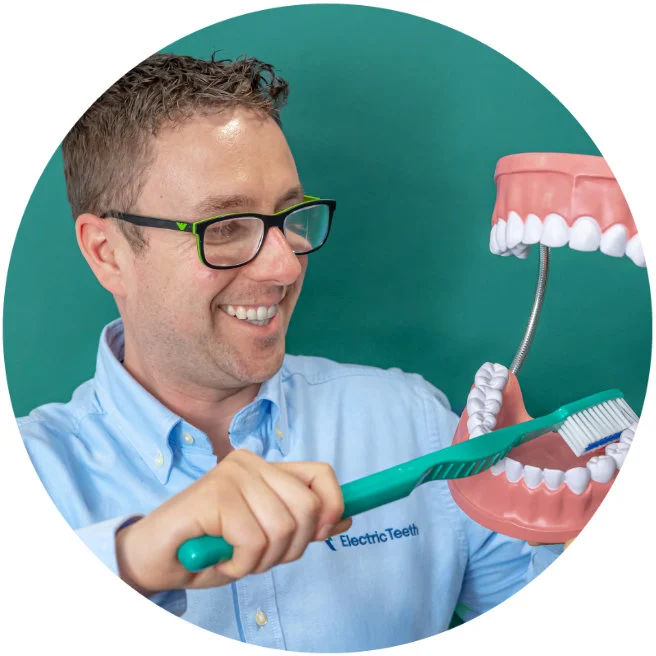
Hi, Jon. A very thorough article...but I need to know which lithium-ion battery it takes. I know Philips says the battery can't be replaced, but I know it CAN be. Problem is the numbers on my battery seem to lead nowhere. The numbers on the base of the toothbrush are HX682P / 190404-3A.
Thanks,
Jon
Hi Jon.
I am afraid this is not something I can help with Jon.
Yes, technically it can be replaced. But, for most individuals, this is beyond their skillset or desire.
Whilst I have a 5100, I don't intend to take it apart and am sorry to say I wouldn't know where to point you to get the right battery.
This is the most thorough and informative review for a product I have ever read. Extremely helpful in deciding to purchase the Philips Sonicare 5100 toothbrush. Thank you very much.
No problem Arlene. I am pleased you found it useful. ☺
If you want to see something very interesting, check out the Fairywill brush heads. All but the p11's fit on the Sonicare Protective Clean 5100. I'm assuming they will fit on many other Sonicare's since the design is very similar across models (the Essence being the exception). How do I know this? I got the Fairywill Pro 2056bk which includes 9 (yes 9) brush heads and they all fit on the Sonicare. The Fairwill brush also comes with 2 sanitizer stations. One is built into the charging base, the other is built into the charging travel case. Just the sanitizer and brush heads alone make the $79 worth it. And thank goodness you can turn the pressure sensor off on the Sonicare. The Fairwill doesn't have much power behind it, but the Sonicare sure does. You can sanitize both Sonicare and Fairywill brush heads with the sanitizer units. It's too bad the Fairywill charger and charging travel case don't work with the Sonicare handle. The prongs are different sizes. Anyone want to take bets the brush heads for Sonicare and Fairywill are made side by side?
Shane.
The Fairywill Pro 2056 is not a model I have yet tested. The brush head design and fitting appears to be different to other Fairywill products like the FW-917 and FW-507 that I have tested previously.
The heads of the Pro 2056 look like they likely could fit to a Sonicare toothbrush such as the 5100. However, I can confirm that not all Faiywill brush heads fit onto Sonicare brush handles. They have a twist and lock mechanism compared to the push on pull off mechanism of Sonicare.
Wow, this is probably the best review I’ve ever read about anything. Great job, thank you.
Do you know how it performs on orthodontics/braces?
Thanks for the kind words Mike.
Assuming you mean traditional fixed braces (metal ones stuck to teeth) rather than the clear aligners that you remove, then the 5100 is great for this.
You still need to floss and use interdental brushes to make sure the brace and all the gaps are cleaned properly, but you can use the 5100 just fine. You don't need any special brush heads or anything like that.
The fact it comes with a travel case is useful if you need to take your toothbrush with you so you can brush after meals like lunch, where you might be out of the home, at work, college etc.
"The ‘Gum Care’ mode is more gentle and does not make use of the full power like the ‘White’ and ‘Clean’ mode do."
By full power are you talking about brush strokes per minute or something else? I was told that the BSPM are the same for Gum mode as for Clean mode. MAybe the last minute of Gum care mode is different, I am not sure. Is there any official documentation form Philips to support this?
Hi Rollo.
I am indeed talking about the brush strokes. It certainly feels like they are less. The intensity of the brushing is not as great as clean or white, feeling softer and more gentle when the gum care mode is running.
I am interested to hear that the brush strokes are the same according to what you have heard. This might be correct. It may well be the 'intensity' of the brushing mode', which is something that can be changed on some models. I am not 100% sure exactly how they have implemented it.
I have asked on several occasions for Sonicare to explain exactly how the modes differ, but no representative has been willing or able to give a detailed explanation, not have I seen any official documentation that explains it either.
How loud is the 5100 compared to other Sonicare models?
Hi Flor,
It is as quiet as any other Sonicare model. It produces an audible humming sound when in operation. It is quieter than an Oral-B electric toothbrush.
Specs from Philips indicate up to 62,000 movement per minute, not 31,000 as indicated here.
Hi Bilyta.
Thank you for spotting the error. This has been updated.
We had written 31,000 movements, but have updated this now to 62,000.
What we should have said is 31,000 brush strokes or 62,000 movements, both apply.
1 brush stroke is equal to 2 movements. (31,000 x 2 = 62,000).
To explain this further you would count 1 movement as the bristles moving from the top to the bottom of the tooth. Imagine a pause, the 2nd movement would be from the bottom back to the top.
A brush stroke on the other hand is counted as the bristles moving top, to bottom and back again.
If you are thinking this is confusing and perhaps a little misleading, we agree, but we can confirm this is correct having spoken to Sonicare staff.